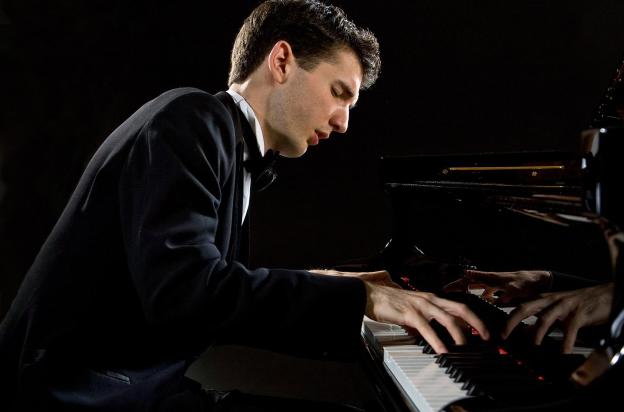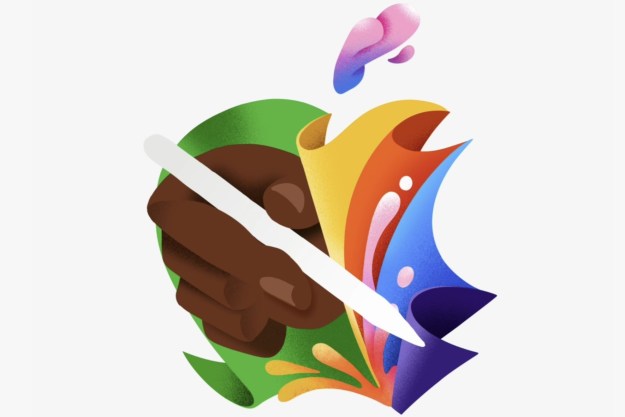
Apple’s iPad is popping up everywhere. It’s used by television hosts, in shops, and even on the flight deck of commercial aircraft. Everywhere. But did you ever think you’d see tablets at a classical music concert? At Cadogan Hall in London on April 25, composer Stephen Goss world premiered of his latest piano concerto with a special twist. For the first time, concert attendees were encouraged to bring a tablet to the show and watch special videos made to accompany the new orchestration. Unfortunately, aside from us, almost nobody did. As it turns out, the classical crowd isn’t ready for modern tech.
That’s not to say the evening wasn’t enjoyable, or that the interactive element was totally ignored, it’s just it gained attention in a different way than we expected.
Classical concerts can be a daunting experience, particularly for newcomers. Stephen Goss’s goal was to use video to both gain an audience, and bring in younger people who use tablets every day. Classical concerts don’t have the same degree of spectacle as one given by Jay Z; but given the right appeal, they can attract a mainstream audience.
“Film scores are complex pieces of music, but people listen,” Goss told us, hoping that “providing a visual link” to his music would open the concert world up in a completely new way, and to a completely new audience.
Everyone in attendance was given the chance to download specially-made videos on their tablet prior to a performance by French pianist Emmanuel Despax, and for the first time ever, encouraged to bring the device with them into the concert. The videos were designed to visually enhance the music, to convey the mood, and to help guide the listener through the emotions and influences of the piece.
Though many concerts have huge video displays above the orchestra, Goss dismissed this idea, as it would have upset the equilibrium of the concert. By encouraging the audience to use a tablet, no-one was forced to join in. “You can start, stop, pause and rewind the video as much as you like,“ Goss said, before quipping, “I don’t even care if people check their email.”
Unfortunately, as lofty as his dreams were, getting people to bring a tablet turned out to be a challenge, and for those that did, downloading the videos wasn’t a one-click process. The videos had to be downloaded from a website before the concert, and transferred to a tablet. Then, each video had to be manually started and stopped at certain times during the performance; there was no audio syncing or anything like that. For those familiar with how classical music is constructed, recognizing the beginning of each movement would have been relatively easy. For an idea that was supposed to encourage tablet users and first-timers to attend, none of it was particularly user-friendly.
Cadogan Hall nestles down a side street in London’s Sloane Square, rubbing shoulders with Tiffany’s, Cartier, Hugo Boss, and the deeply hip bar The Botanist. Once inside, it’s all high ceilings and stained glass windows – not very high-tech at all. Before putting on the show, Goss had already had run-ins with the traditionalists, who were horrified at the idea of bright screens, email notifications, and the sound of Angry Birds ruining their concert.
To get an idea of just how vilified an iPad (or a smartphone, for that matter) normally is in this environment, a member of staff approached me after I had taken my seat, and said not only must the tablet I was preparing for the show be put away before the start, but it couldn’t be used at any point as its bright screen may upset the audience. It was a misunderstanding that was soon cleared up, but it highlighted how tough it would be for mobile tech to be accepted as a regular guest.
Goss’s piano concerto was split into four movements, Fanfare, Moto perpetuo, Adagio, and Finale, and ran for around 24 minutes in total. The music was distinctly cinematic, and the video increased the effect, with parts that brought to mind the wonderful opening scenes of Woody Allen’s Manhattan. For me, as someone who only occasionally attends classical concerts, this gave the new piece some familiarity and immersed me far earlier than I expected.
My enjoyment of the concert was increased by using a tablet, and I was more engaged than perhaps I would have been without the “crutch” of the video. My iPad sat on my knee, never became annoying, and crucially, didn’t stop me paying attention to the brilliance of the musicians. At the risk of sounding like a cliche, it brought the music to life, which for those who don’t understand the finer nuances of classical composition, is crucial. What’s more, the interactive element certainly got me there in the first place, as I wouldn’t have attended – or even known about it – if it didn’t exist. But then again, while I may be a part of the valuable tech audience, I’m definitely no 20-something.
Although I embraced the concert’s tech aspect, there just weren’t all that many other tablets to be seen. “We had read this would be an interactive experience,” said one couple, but because they didn’t own a tablet, they weren’t able to join in. A father and his young daughter, seated behind me during the performance, were in the same situation, but instead of being distracted by the light from the screen on my tablet, took the opportunity to watch some of the footage over my shoulder.
The intermission proved to be the perfect time to play spot the tablet. Of the dozens of people filing past only one person, who turned out to be one of Cadogan Hall’s directors, was holding one. She was still processing the experience, but her initial reaction was that it didn’t add much to the power of the performance; although she saw its potential. At this point, another audience member joined in with the discussion, questioning whether watching a video whilst listening to the music was constraining, and the mind’s eye would be influenced instead of free to make its own associations. The conversation then switched to the concept of watching the videos again later, and if they would bring back the emotion of the music.
It was then I realized that of the half a dozen people I’d spoken to over the course of the evening, only one had actually watched the videos during the concert. It wasn’t through lack of interest, though. People enjoyed watching the videos even without the sound, and everyone I spoke to was aware it was part of the performance, but didn’t own the requisite hardware which was needed to take part.
Fascinatingly, the technology became as much of a talking point as the music, almost like the pyrotechnics at a rock concert; adding another dimension to the subsequent discussion. It also seems the innovative idea of using tablets to encourage more people to attend, may end up motivating those who weren’t the target audience to go out and buy one.
Goss saw the video project as an early step in expanding the classical audience, and hoped its uniqueness would help keep the art alive, but his wish to bring in a younger audience didn’t seem to work; the average age of the patrons was well over 40. Also, seeing as only half a dozen people (including me) used a tablet during the performance, he wasn’t very successful in his quest to integrate music and tech. However, for this classical newbie, Goss’ tablet-driven, interactive classical concert fulfilled its promise. I really enjoyed the visuals. As someone who feels as passionately about tech as many of my fellow attendees did about music, Goss’ transformation into an unintentional tablet ambassador was intriguing.
So did Goss achieve what he set out to do? Not really, but pioneers rarely do. However, in time, this kind of thing could catch on. This concert could push more composers to experiment with gadgets in the future, which may see them become commonplace at concerts – something which has to happen before newcomers start to fill seats. There’s a long way to go, but Stephen Goss may turn out to be a trailblazer yet.
(Photo © Clive Barda, video files for the Emmanuel Despax concert © Orpheus Foundation)
Editors' Recommendations
- Apple’s new iPad Air could be in trouble
- Stop! Don’t buy this iPad at Best Buy today
- Best Apple deals: Save on AirPods, Apple Watch, iPad, MacBook
- Apple is about to do the unthinkable to its iPads
- The best iPads in 2024: the 5 best ones you should buy



